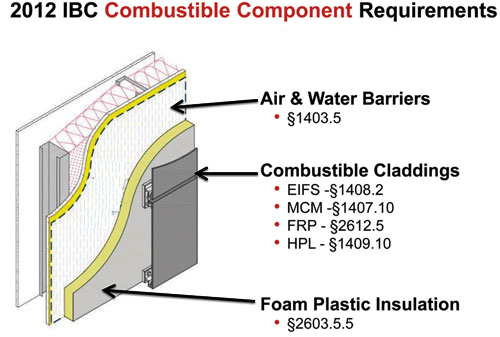Navigating Wall Assembly Fire Testing
However, it's the foam plastic insulation on buildings of any height, other than construction type V, and air and water barriers and combustible claddings—EIFS, MCM, FRP, and HPL—on buildings taller than 40 feet above grade, which are categorized as construction types I-IV, that will subject an assembly to NFPA 285 testing.
Incidentally, it's important to note that the 2012 IBC also prescribes that these components meet the following ASTM requirements:
- Flame Spread Index ≤25 (ASTM E84)
- Smoke Development Index ≤450 (ASTM E84)
- Maintain assembly fire rating (ASTM E119/UL 263)
 |
|
Within a building enclosure, the following components are combustible and subject to NFPA 285 testing. Image courtesy of DuPont Building Innovations |
In terms of the NFPA 285 test itself, Vecchiarelli explains, “the intent of the test is to evaluate the fire propagation characteristics of exterior non-load-bearing wall assemblies. The two-story test involves two burners, one placed inside the first-story test room, and the other in a first-story window opening.
“The test runs for 35 minutes,” she continues. “Test results include flame propagation measurements, thermocouple temperatures, and observations made during the test.”
In order to pass the test, the wall assembly may not allow any flame propagation to the second-story room and none of the thermocouples, which are placed throughout the wall assembly, can exceed 1,000°F. Externally, the flames cannot propagate 10 feet above the top of the window, nor can they travel more than 5 feet laterally from the centerline of the window.









